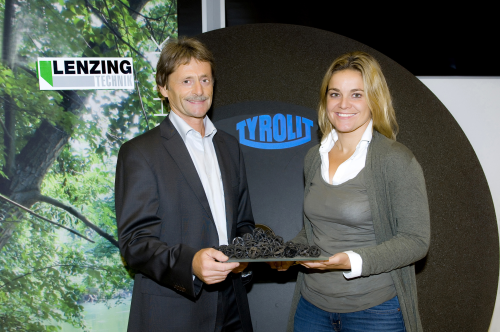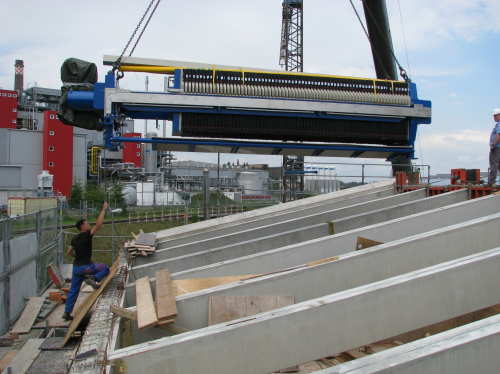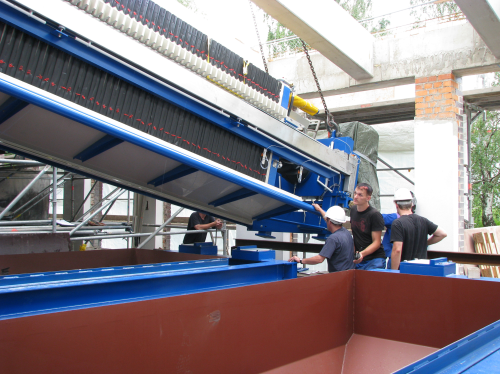


Biological exhaust air purification
Tyrolit Schleifmittelwerke Swarovski KG of Austria is one of the world’s leading manufacturers of grinding tools. In order to satisfy the strict requirements placed upon environmentally-compatible production processes, Lenzing Technik GmbH was selected to set up two biological exhaust air purification facilities. These BRI BIOReaction models are located at Tyrolit’s main production base in the Tyrolean city of Schwaz. The first facility in Schwaz was established in late 2011, while the second will follow in summer 2012. Each of the facilities will use advanced biological methods to scrub 17,000 m3/h of exhaust air. The new system thus has a significantly higher rate of performance and an ease of maintenance than the previous one. “The patented BIOReaction process facilitates the efficient removal of odours and volatile organic compounds,” explains Herbert Hummer, Lenzing Technik’s managing director. The process joins two proven technologies of exhaust gas treatment: one chemical/physical and the other biological. In the first stage of the system, a bio-washer is used to remove water-soluble components from the exhaust air. The second stage is comprised of a biofilter containing the optimised BioMatrix™ bedding materials. These are comprised of fillers filled with specially processed compost. Its bacteria and fungi handle the oxidation of the pollutants found in the raw gas. The organic components are transformed into oxygen, water and CO2. The contaminants are then adsorbed and, in the final step, biologically degraded. In autumn 2011, the team from Lenzing Technik took apart the first of the two biofilters in Schwaz. The filter has come to the end of its operating life. The next steps were to adapt the foundations and to then – within only three weeks – assemble the higher-performance BIOReaction facility. The same procedure is planned for summer 2012. The second facility will treat the exhaust from the second production unit, which features a large number of dry kilns used in production of synthetic resin-faced grinding wheels. The extremely tight schedule of revamping results from agreements reached with authorities and from the fact that Tyrolit’s full order books do not permit any long production downtimes. Meeting this schedule was essential.
Rapid assembly of industrial wastes facility
In December 2010, a fire destroyed a large portion of the chemical/physical treatment facility operated by Sächsischer Umweltschutz Consulting GmbH (SUC) in Freiberg Germany, thus crippling it. Lenzing Technik GmbH was commissioned by SUC with getting its facility, which processes liquids and sludge stemming from the solar, photovoltaic and electronics industries, back into operation as soon as possible. This €1.1 million commission was awarded in March 2011, which was completed in only five months and 3,500 hours of manufacturing and assembly work. SUC maintains seven facilities in Germany. At them, 180 staff members recycle and dispose of industrial wastes. The main items handled in CPA Freiberg are waste acids and lyes containing heavy metals from the solar, photovoltaic and electronics industries. Also processed are drilling and grinding oil emulsions produced by the industrial engineering industry. These waste liquids and sludge are generally shipped to the facility by tank trucks or in IBC containers. The wastes are first subjected to an initial analysis, and then conveyed to be correspondingly treated. Acids and lyes are neutralised. Solid materials that have been filtered out are consigned to dumps, with the filtrate being sent to the local sewage treatment plant for further processing. Coagulants are used to separate the drilling and grinding oil emulsions yielded from industrial engineering operations into oil and water. The oil separated out is employed as a fuel. Flocking agents and catalysts and activated carbon are used to further treat the aqueous phase, which is then fed into the local sewage system. Handling the commission required expertise in engineering, logistics and manufacturing. “Since CPA Freiberg’s facilities were urgently needed by the large-sized industrial community in Greater Dresden, there was no room for delays,” notes Herbert Hummer, Lenzing Technik’s managing director. Not more than five months – starting with their commissioning in March 2011 - were assigned to the Lenzing Technik’s specialists for the engineering, production, assembly and putting into operation of the facility. Accomplished during this time was the design, production and commissioning of the facilities for the full-scale dewatering of sludge, scrubbing of air emissions, separation of emulsions and the generation of compressed air. The commission also included the construction of the steel structure and the installing of pipes and the measuring, control and regulation equipment. The fact that CPA had to remain in operation during the revamping proved to be a further logistic, production and technological challenge. Lenzing Technik was responsible for managing the project as a whole, and for the production and the assembly of the emissions scrubber. In response to the client’s wish, subcontractors – mostly local - supplied the plant’s other components. In order to be able to guarantee meeting the deadline for completion of the facility by August 2011, detailed plans and procedures were drawn up for the work undertaken by the project partners. Despite this, the in-depth plans formulated by Lenzing’s team also had to be adapted to respond to unforeseeable challenges. One of them was a two-week delay in the delivery of the filter presses, which meant that they had to be assembled prior to the building of the roof. “The extreme time pressure allowed for no delays in construction,” recalls Burkhard Rohm, head of project at Lenzing Technik. A crane was finally used to lift the presses and place them between the – already installed – top floor rafters of the roof. “Each filter press is eight metres long and weighs 20 tonnes. It had to be lifted through an opening that was a mere few millimetres larger than the press itself,” explains Rohm. The facility processes an extremely broad spectrum of highly variegated wastes – ranging from highly-concentrated acids to highly abrasive liquids. Since August 2011, the facility has been processing up to 220 cubic metres of organic and inorganic wastes a day.




